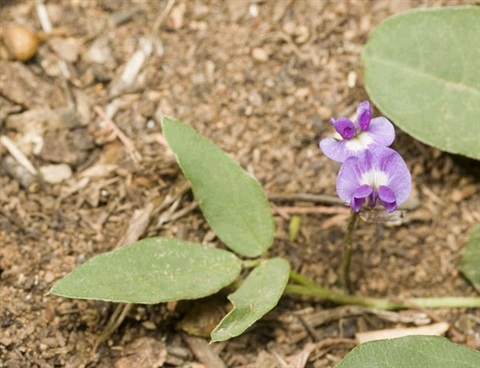
Glycine tabacina
Variable Glycine
Scrambling or twining herb with long stems, scrambling plants rooting at nodes.
Additional information
- FamilyFabaceae
- StoreyLower storey
- SizeTwining 0.2-2 m
- Plant groupingClimbers & creepers
- LeavesScattered leaves divided into 3 stiffly hairy leaflets, on stalks 5-50 mm long. Lower leaflets broad to elliptic 10-15 mm x 8-14 mm, upper leaflets elliptic-lance-shaped to egg-shaped 0.7-6 cm x 3-10 mm, terminal leaflet largest, on a longer stalk.
- Flower colourBlue to purple
- Flowering timeOctober to May
- FlowersLoose sprays of 4-12 pea flowers on stalks 2-12 cm long in upper axils.
- Bird attractingNo
- Butterfly attractingBoth food for caterpillars and nectar for butterflies.
- Frog habitatNo
- Growing conditionsWell drained soils in grassy forests and woodlands. Sensitive to frost. Full sun, partial shade.
- Garden useAn attractive light scrambler for dryer gardens. Allow to scramble on fences or amongst shrubs.
- Commercially availableNever
- Conservation statusSignificant within the Shire. Known from very few local sites. More common outside the Shire boundary.
- Aboriginal Use Food - taproot chewed
- Related speciesGlycine latrobeana has been noted as occurring in the Shire. It is likely to be a misidentification for G. tabacina which occurs in the same area. G. latrobeana has shorter, erect, non-twining stems, roundish, often stalkless leaflets & lacks leaf-like bracts.
Photo Gallery
Photographer/s: 1 M. Parkes © Australian National Botanic Garden; 2, 3 Murray Fagg © Australian National Botanic Garden
Plant Communities